Experts say it is just a matter of time
BY NORM TOLLINSKYAccess to Canada’s vast, mineral-rich hinterland could be the main driver for the reintroduction of a mode of transportation that fell out of favour with the Hindenburg disaster of May 6, 1937.
At ISO Polar Airships’ Aviation Innovations Conference in Toronto, March 14 and 15, several mining industry delegates voiced support for using cargo airships to build mines and transport concentrate to processing facilities.
The conference attracted 75 delegates, including representatives of eight airship companies from Canada, the United States, Russia and France. Also in attendance were representatives of De Beers Canada, Torngat Metals Ltd., and Tugliq Energy, an independent power producer responsible for the wind-powered smart grid development at Glencore’s Raglan Mine.
Northern Ontario speakers included Laurentian University associate professor David Robinson, Centre for Excellence in Mining Innovation president Doug Morrison, and Nancy Wood, president of First Logistics, a First Nation-owned company responsible for the maintenance of the 312-kilometre ice road connecting four James Bay communities.
ISO Polar president Dr. Barry Prentice, a professor of supply chain management at the University of Manitoba, attributed the success of the conference to “the growing realization that there is no other alternative” if we are going to take advantage of Canada’s mineral wealth in the Far North.
For example, Torngat Metals Ltd., a privately-held exploration company with a rare earth deposit on the Quebec-Labrador border, 250 kilometres north of Schefferville, has signed a memorandum of understanding with Straightline Aviation to use Lockheed-Martin LMH-1 hybrid airships as an alternative to building a road to the proposed minesite.
Lockheed-Martin is halfway through a certification process for the LMH-1 and could have one in the air in two years, said Prentice. A non-rigid, blimp-type craft, the LMH-1 accommodates a payload of 20 tonnes and could be used to transport concentrate to Schefferville.
According to Prentice, it’s entirely possible that future airship designs will be able to accommodate payloads of 100, 200 or even 250 tonnes.
De Beers is also interested in airships, said Prentice, because the diamond deposits left to be found are smaller and don’t warrant the cost of building expensive transportation infrastructure in Canada’s Far North.
“Then, there’s the Ring of Fire,” said Prentice. “It’s been sitting idle for 15 years. They could already have been mining there for a decade if airships were available.
“How else do you deal with the fact that in 70 per cent of Canada’s landmass, there are no roads and no hope of getting roads?” he asked. “We have a treasure chest of mines in the North that we can develop and we have communities living in third-world conditions. It’s all about transportation, so this is a technology whose time has come.”
Prentice is also president of Buoyant Aircraft Systems International, a Canadian-based company that hopes to develop an airship designed to meet the unique conditions of Canada’s Far North. Non-rigid, blimp-type airships currently used for advertising purposes, as well as most other airship companies, including Lockheed-Martin, use helium. Buoyant Aircraft Systems is unique in that it plans to use hydrogen – currently banned by the U.S. and Canada because of its flammability.
Prentice, however, claims the original U.S. decision to ban the use of hydrogen in 1922 was politically motivated “based on the demands of some people who built a helium refinery and had no market for it. People have this idea that the ban occurred because of the Hindenburg accident, but that’s not true.
“The suspicion is that the Hindenburg disaster was caused by a lightening strike and accumulated static electricity on the Zeppelin, which wouldn’t be an issue today because we have ways of bleeding off static electricity. Hydrogen also took the hit because it played well for the Allies to vilify the Nazis.”
Hydrogen, said Prentice, is the only portable fuel we have that isn’t carbon based, and unlike helium, it’s a fuel that can be produced in Canada’s North using wind or solar power, as is the case at Glencore’s Raglan Mine.
“If a helium-filled airship runs into a problem at a remote site and needs more gas, how do you get it there?” asked Prentice. It can’t be produced onsite. It’s expensive, and often difficult to source.
Most airship companies, he said, have stayed away from hydrogen because they’re afraid the government won’t change the regulations and they don’t want to scare away investors.
Buoyant Aircraft Systems proposes a rigid-type airship that would hold its shape in Canada’s winters and operate year-round unlike non-rigid, blimp-type craft filled with gas that will shrink in cold temperatures.
The Buoyant Aircraft design includes a winching system to secure the airship and a fixed, turntable-style base with an apron area for transferring cargo from airship to truck. The circular turntable will ensure that the nose of the airship is always facing the wind.
“We will also need water at the base because if the airship has 10 tonnes of lift and you take the cargo off and don’t put anything on, your next stop is on the way to Mars,” said Prentice. “So, as soon as the airship lands, the first thing you do is load 10 tonnes of water.”
Prentice estimates his company will need $5 million to build a demonstrator and $500 million to certify and build a full-scale airship, but government assistance, he said, will be required to make something happen.
“The Canadian government has been sitting on the sidelines and hasn’t done anything to encourage the industry,” complained Prentice. “There are no other solutions. We can’t build roads everywhere because it’s just too expensive.
“If you look back to the 1930s, we had commercially produced electric cars, commercially produced windmills and commercially produced airships, and they all disappeared because of fossil fuel alternatives, including coal fired electric plants, gasoline cars and jet engines.
“Today, wind turbines are back big time and electric cars are coming back. Airships will be next,” he predicted.



